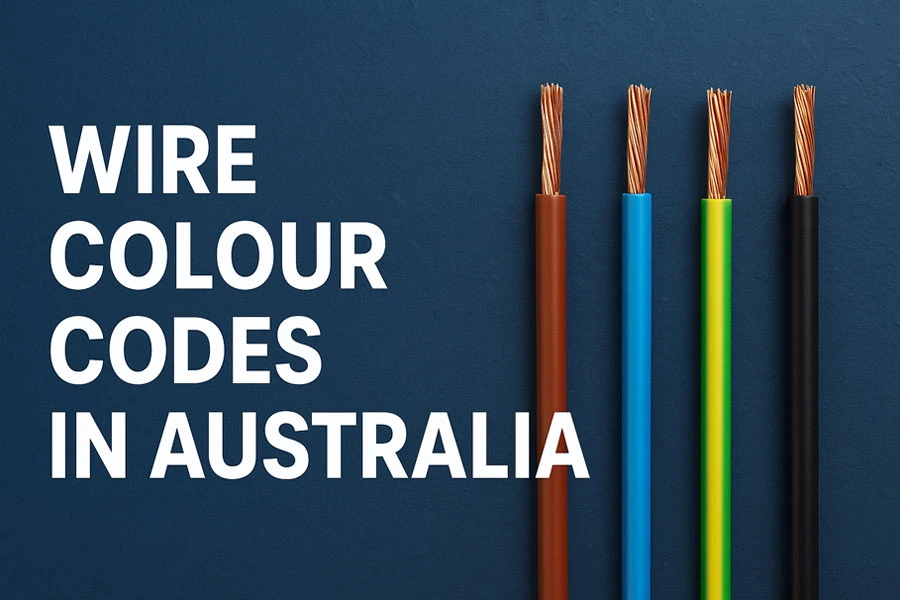Whether you’re moving into a new property in Wollongong or simply curious about the wiring in your home, understanding wire colour codes in Australia is essential. The colour of each wire isn’t random—it’s a critical safety measure that helps electricians quickly identify the purpose of each wire and reduce the risk of electrical accidents.
But here’s the catch: wiring standards have changed over time. That means older homes across Wollongong and the Illawarra may still have outdated wiring colour codes, which can be confusing—or even dangerous—if you don’t know what you’re looking at.
In this guide, we will break down the current Australian wire colour codes, old colour codes, and what homeowners need to know to stay safe.

What Are Wire Colour Codes?
Wire colour codes are a standardised system of colours applied to electrical wiring. These colours allow electricians to quickly identify whether a wire is live (active), neutral, or an earth wire.
The purpose is simple: prevent accidents, improve efficiency, and ensure that wiring is consistent across the country.
Current Australian Wire Colour Code (AS/NZS 3000:2018)
Since 2000, Australia has aligned its wiring colour standards with international regulations (IEC). These are the colours you’ll see in modern homes and buildings today.
Single Phase Wiring (most Australian homes)
- Active (live): Brown
- Neutral: Light Blue
- Earth (ground): Green/Yellow
Multiphase Wiring (commercial & industrial use)
- Phase 1: Brown
- Phase 2: Black
- Phase 3: Grey
- Neutral: Light Blue
- Earth: Green/Yellow
Quick Tip: If your Wollongong home was built or rewired after 2000, it should use these colours.
Old Australian Wire Colour Codes (Pre-2000)
If your property is older, you may encounter outdated colour codes. This is where confusion—and danger—often arises.
Single Phase (old system)
- Active (live): Red
- Neutral: Black
- Earth: Green
Multiphase (old system)
- Phase 1: Red
- Phase 2: White
- Phase 3: Blue
- Neutral: Black
- Earth: Green
Important: Black wires under the old system were neutral, but under the new system, black wires are live in multiphase setups. Mixing up these two standards can be very dangerous.
Why Do Wire Colour Codes Change?
Electrical safety standards are regularly updated to:
- Align with international standards.
- Reduce confusion when working across different countries.
- Improve home and workplace safety.
This is why a licensed electrician should always inspect wiring in older Wollongong properties—especially if you’re renovating or upgrading switchboards.
Common Exceptions to Wire Colour Codes
Not all wires in your home follow these codes. Some exceptions include:
- TV aerial cables: Often brown, but they don’t carry live voltage.
- Appliance cables: Black cords may supply power but differ from fixed installation wiring.
- DIY modifications: Unlicensed electrical work may not follow any standard—making it especially risky.
Can Homeowners Use Wire Colour Codes for DIY?
Knowing the wire colour codes is useful for awareness, but it doesn’t make electrical work safe for DIY.
Even if you can identify wires by colour, risks include:
- Older properties with outdated wiring.
- Incorrect DIY work done by previous owners.
- Faults those aren’t visible just by looking at wires.
In Australia, it’s illegal for unlicensed individuals to perform most electrical work. Always call a licensed electrician in Wollongong for rewiring, switchboard upgrades, or repairs.
Stay Safe: Call a Licensed Wollongong Electrician
Understanding wire colour codes in Australia is just the first step. But if your property has older wiring or you’re unsure about its safety, it’s best to get expert help.
At Stuart Johnston Electrical, our licensed electricians in Wollongong provide:
- Wiring inspections
- Switchboard upgrades
- Electrical safety checks
- Rewiring for renovations and new builds
Call us today on 0418 422 182 to book a safety inspection or free quote.
FAQs about Wire Colour Codes in Australia
1. When did Australia change wire colour codes?
Australia changed to the current international standard in 2000, with full adoption across the industry soon after.
2. Are old wire colours still safe?
Yes, if properly installed and maintained—but they may not meet today’s standards. It’s best to have them checked by a professional.
3. What happens if I mix up the colours?
Incorrect wiring can cause electrical fires, equipment damage, or electrocution. Always leave electrical work to a licensed electrician.
4. Do appliance cords follow the same colours?
Yes, since the introduction of the new standard, most appliance cords match the installation wiring scheme.

